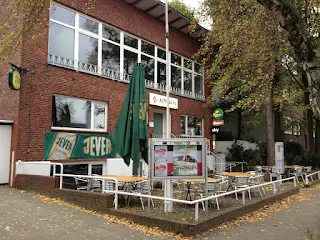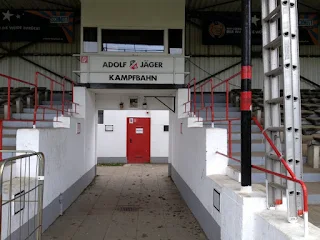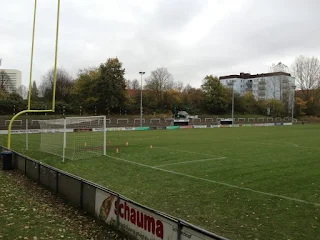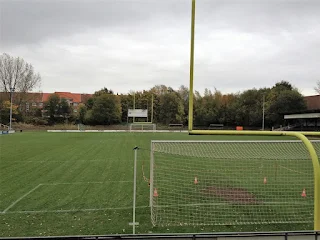Altona 93, Altonaer Fußball-Club von 1893 e. V. to give them their full title, is one of Germany's oldest football clubs, based in Altona, the farthest western district in Hamburg, in the north of the country. The club was originally known as Altonaer Cricket Club, with the sport quite popular at the time.
They were renamed Altonaer Fussball und Cricket Club and then Altonaer Fussball Club in quick succession as members of the Altona-Hamburg Football League. The club were the host of the first ever German National Championship Final, when VfB Leipzig played DFC Prague, with AFC player Franz Behr refereeing at Exerzierweide.
In 1902-03, Altona reached the national semi-finals, where they went down to VfL Leipzig around the same time as moving into their new AFC-Kampfbahn home stadium. Another German championship semi-final was reached in 1908-09, where Berlin TuFC Viktoria 89 proved too strong.
In 1919, the club merged with Altonaer TS 1880 to become known as VfL Altona. This lasted for just three years before the club took on the title of Altonaer FC 1893 VfL. Yet another merger occurred in 1933, when a partnership with Borussia 03 Bahrenfeld created Altonaer FC 93 Borussia.
Under the Third Reich, German football was divided into sixteen top divisions, with Altona being placed in the Gauliga Nordmark and then the Gauliga Hamburg. The team struggled in the league, avoiding relegation on a couple of occasions before finishing third in 1942-43.
In 1944, the Kampfbahn was renamed the Adolf-Jäger-Kampfbahn in honour of a German amateur international who was killed in an air raid. Altona finished as Gauliga Hamburg runners-up in 1944-45 before becoming members of the Stadtliga Hamburg, where third place was achieved in the inaugural season.
The team went on to become Elbestaffel champions in 1947-48, which was repeated in 1949-50, from where Altona went up to the top flight Oberliga Nord through the ascent round, although their spell lasted just one season. Back in Amateurliga Hamburg, Altona finished as runners-up in 1951-52, which was a springboard for promotion.
It led to an Oberliga third place in 1953-54 before the team embarked on a great run in the DFB-Pokal, German Cup, the following season. 1. FC Saarbrücken, Eintracht Frankfurt and Alemannia Aachen were defeated before AFC went out in the semi-finals after a replay to eventual winners Karlsruher SC under coach Klaus-Peter Kirchrath.
Another third-place league finish followed in 1957-58 under trainer Heinz Spundflasche. A capacity crowd of 27,000 filled the Adolf-Jäger-Kampfbahn on a couple of occasions for the derby against Hamburger SV as crowds flocked to watch the likes of Heinz Spundflasche, Werner Erb and Dieter Seeler in the red, white and black of Altona.
The team continued in Oberliga Nord until the end of the 1962-63 season, in which they couldn’t have picked a worse time for a bad season of results with the introduction of the Bundesliga for the following campaign. Fortunately, the team performed in the play-offs to win a place in the second national level Regionalliga Nord.
Fourth place was achieved in the league by Jockel Krause's side, but it was again the DFB-Pokal that brought the club headlines. Borussia Mönchengladbach, Duisburger SV and Karlsruher SC were defeated before Altonaer FC 93 fell to cup winners TSV 1860 München after extra time, with Peter Kautz scoring the consolation goal.
It was third place again under coach Kurt Krause before the team was relegated in 1967-68 back to Landesliga Hamburg, before another drop to the Verbandsliga in 1969-70. In the renamed Amateurliga Hamburg-Hansa, Altona were crowned champions in 1971-72 before winning the Hammonia title in 1983-84.
AFC won their ascent round to win promotion to mark a return to the third-tier Oberliga Nord, which was marked with fourth place in 1985-86 with Willi Reimann coaching the side. Many mid-table finishes were ended in 1992-93 when Altona went down to the Verbandsliga. The team fought back to win promotion to Staffel Hamburg/Schleswig-Holstein of the Oberliga for the 1994-95 season.
The team won the title the following season to go up to the third-tier Regionalliga Nord. Altona found the going too tough and went down twelve months later. For financial reasons, the club opted to drop two levels to the Verbandsliga from where they progressed to the fourth level Oberliga Nord Hamburg/Schleswig-Holstein in 2001-02.
Altona finished as runners-up in 2003-04 before the competition became just one league for the following campaign. Altona stabilised and produced some decent league placings, including 2007-08, with Torsten Fröhling in charge of the team, which was enough to secure a place in Regionalliga Nord after the inauguration of 3. Liga.
AFC went down in 2008-09 to Oberliga Hamburg, where they finished third on their return to fifth-tier football before a runners-up place in 2012-13 and then third the season after. Altona were the best placed club, in third, who applied for promotion in 2016-17 under trainer Oliver Dittberner. The team moved back to Regionalliga Nord after progressing in the play-off round in second place.
This came after a win against FC Eintracht Northeim and then a draw at home to Eutin 08 in front of over 3,000 fans. However, the jump proved too much with Altona dropping straight back down in bottom place in 2017-18 before they bounced back to be crowned as Oberliga Hamburg champions in 2018-19 under coach Berkan Algan as Marco Schultz put away the goals.
When the 2019-20 season was aborted owing to the COVID-19 pandemic, Andreas Bergmann’s side were in third from bottom place but were reprieved from relegation. Meanwhile, interesting news materialised regarding a new stadium for the club.
The club would relocate to a new build next to Diebsteich rail station on Waidmannstraße, close to the Rudi-Barth Sportplatz home of SC Union 03, with a scheduled opening in 2029, with the project to include a stadium, music hall, commercial space, and renovation.
The team was relegated in 2020-21 with Andreas Bergmann overseeing team affairs, before a fourth-place was accrued in Oberliga Hamburg twelve months later as Michael Gries weighed in with the goals. Rasmus Tobinski and Veli Sulejmani helped their side to the title the following season, where promotion was denied in the playoff rounds.
2024-25 saw Altona again lift their Oberliga crown, and this time they went back up to the fourth-tier Regionalliga Nord.
Altona 93 will play in the Regionalliga Nord in the 2025-26 season.
My visit
Monday 29th October 2012
I had woken in decent shape and wanted to discover stadiums. I'd already been to the home of Victoria Hamburg and wanted to fit Altona in before heading up to Stellingen for the midday tour around the Imtech Arena and to learn all about the city's prominent club, HSV.
After more confusion, which led to me stumbling across the home of FC Teutonia 05, I was soon on the main Behringstrasse. I took advantage of spotting that several buses ran along there back to Altona station, which cheered me up no end. It had been further than I'd anticipated.
The far side was open terracing, with the near end grass banking. The arena looked like it once had a running track around it, albeit not one that detached fans too far back from the action. It was interesting to see American Football goalposts standing behind the goals. A real example of getting the most from a ground.
I headed away and thanked my friend and his colleague. Fortunately for me, a bus was soon at my stop, and I enjoyed a leisurely ride back before the ride to a grander, but less intimate venue. I had grown a soft spot for Altona and the Adolf-Jäger-Kampfbahn as I had earlier at Victoria. I was already hoping for a return, maybe as a weekend double header?















No comments:
Post a Comment